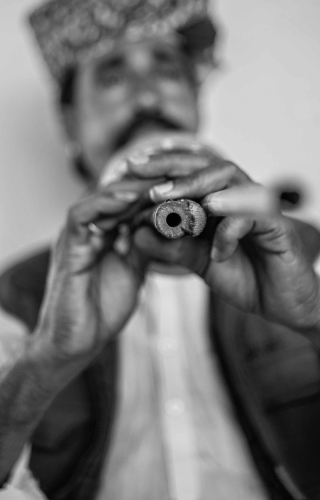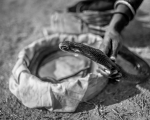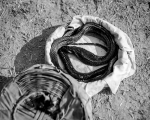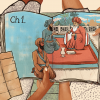Guru Gorakhnath, the founder of the Nath sampradaya, was known for his magical powers. When he was put to test by his disciples, the Guru told them that whatever they would ask for, he could make it appear. Kanipa (alternately Kanifanath), one of his close disciples, asked for a bowl of venom, thinking that Guru Gorakhnath would not be able to procure it. But the Guru surprised his disciple and presented him with venom from a snake. the Guru then instructed him that from that time onwards, Kanipa and his followers would be associated with this animal and it would be his responsibility to protect snakes. Humbled by this experience, Kanipa adhered to Gorakhnath’s words, and that is how the Jogi Nath community, or Kalbeliyas as they are popularly known, came into being. This is the origin story the community believes in.
Kalbeliyas are snake catchers (sapera). They have an innate knowledge of different types of snake species found in Rajasthan, how to track them, how to detect their well-hidden lairs, how to handle them safely, how to extract their venom and how to cohabit with them. For these special skills, Kalbeliyas were tasked to catch and rescue snakes if any strayed into a home or village. Snake-catching provided them with the opportunity to educate villagers not to harm snakes and how it plays an important role in the ecosystem by keeping control over pest populations, including other snakes. In return, villagers provided alms and food for their snake-catching services.
Snakes are sacred to Kalbeliyas, and they form a lifelong bond with them through music. They are the pioneers in the development of wind instruments like the been and pungi. They believe their musical gift is a blessing from their Guru, using which they are able to hypnotise and catch snakes. Whenever a snake was caught, a performance was put up in front of villagers. Playing a rhythmic tune on the been, the sapera would ‘charm’ the snake by swinging the been in front of the snake (snakes can’t hear music, but follow the swinging movement of the been). Over centuries, snake performance became a source of public entertainment, and saperas made a living as itinerant snake charmers. Young boys would accompany elders, learn snake-catching and dance to the music, the ever-popular nagin (snake) dance. Snake-charming became a stereotype of India in the western imagination.
Kaal means death, a metaphor for the Indian cobra—hence Kalbeliyas handle ‘death’. Even the lethal venom of the cobra does not scare them. For them, any snakebite can be cured, provided the victim is brought to them immediately. In toxicology, snake venom (zootoxin) is essentially a mix of thousands of proteins, notably neurotoxins which immobilise prey, and hundreds of enzymes that help in the digestion of prey. These complex proteins can have a range of effect on the human body. For example, neurotoxins damage the nervous system, myotoxins damage muscles, cytotoxins damage cells and hemotoxins damage red blood cells. The antidote to snake venom depends on the type of snake. Kalbeliyas administer antidotes by physically feeling the intensity of cold/hotness or numbness in and around the bite mark. They have knowledge of Ayurveda medicine and keep medicinal herbs. Using a mixture of various herbs and a combination of chants, Kalbeliyas save many victims of snake and scorpion bites. They perform the role of medicine men, especially in rural Rajasthan where access to antivenom serum is limited.
Traditionally, while young boys and adult men went out to catch snakes and earn a living as saperas, women in the Kalbeliya community worked as midwives and healers. Once they set up their temporary camps close to a village, Kalbeliya women would be visited by pregnant ladies and girls with their various health issues. One of the most sought-after concoction is soorma that the Kalbeliyas prepare from snake venom and a mixture of herbs and oils. The white, waxy paste is known to prevent and cure eye disease. All members of the tribe use soorma from a very young age, and they believe that no Kalbeliya would ever go blind or need glasses to read. This treatment is still in demand in far-flung areas of Rajasthan.
Travelling with their camels or carts, Kalbeliyas erect makeshift shacks or tents outside villages. Literally and socially, they live on the fringes, because they are considered of low caste. Due to limited integration in society, they have largely retained their nomadic lifestyle. Some depend on agricultural work for sustenance. In the past, the mere presence of Kalbeliya camps alerted villagers, and they would give them food and water as a sign of respect for their veneration of the naga, held sacred not only by Kalbeliyas, but by all Hindus as semi-divine deities and by women as a symbol of fertility and Lord Shiva.
In 1972, Kalbeliyas faced an existential crisis when the Wildlife Protection Act came into being and the Indian government and various animal welfare organisations cracked down against wildlife hunting and trade in animal parts. This severely impacted profession that depended on wild animals, like snake catchers and snake charmers. Saperas had no other option but to give up their traditional occupation, which was their only source of income. This is when women of the community were forced to take up a more active role and train themselves as professional dancers to cater to the growing tourism industry in Rajasthan.
Then came Gulabo Sapera. From a very young age, she would accompany her father to catch snakes and swayed to been music, mimicking the swinging movement of snakes. She started her dance career in 1981, at age 10. Now an internationally acclaimed performer and Padma Shri recipient (2016), Gulabo Sapera is the first woman from the community to perform Kalbeliya dance in front of audiences, both at home and abroad. Kalbeliyas credit her for making the dance easily identifiable with Rajasthani culture. Seeing her success, young girls began learning dance from Gulabo Sapera and a community that was once known as snake charmers is now recognised for their music and dance.
Kaalbeliya song and dance has gained popularity across the world and has provided the community with a stable source of income. Students come to Rajasthan from across the world to learn from Kalbeliyas. Many Kalbeliyas have abandoned their peripatetic lifestyle and have shifted to cities with high tourist footfall. They are hired by hotels, tour companies and by the government to perform for guests or in festivals. Some have their own band ensembles that are hired during weddings. Those with high income have built permanent houses and send their children to school. However, the community was severely hit during the Covid-19 pandemic in 2020 and the aftermath of the lockdown. With no tourists to cater to, they were out of work for months and depended on donations to sustain themselves.
Kalbeliyas are tenacious people, living a tough life in Rajasthan’s hostile environment and desert ecosystem, with meagre resources. They have shown remarkable ability to adapt according to the times and have created a distinct identity for themselves. The history of Rajasthan has been shaped by heroic tales of Rajput warriors and famous battles, but unfortunately, the contribution of Rajasthan’s tribes and smaller communities are overlooked in this grand narrative. Kalbeliyas were guardians of nature much before wildlife conservation was a field of science. In India, thousands of people die each year from snakebites, a major menace in rural India. Particularly vulnerable are young children. Using their knowledge of biodiversity, animal behaviour and expertise in game tracking, Kalbeliyas can play an important role in the fight against snakebite deaths in Rajasthan and other states in India. The sapera has not played his last song yet.
This content has been created as part of a project partnered with the Royal Rajasthan Foundation, the social impact arm of Rajasthan Royals, to document the cultural heritage of the state of Rajasthan.

















